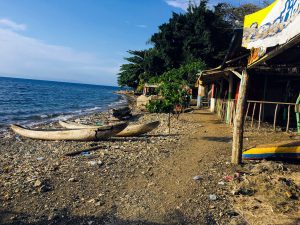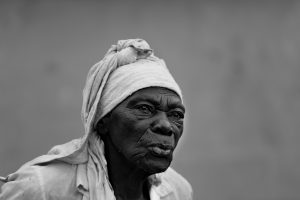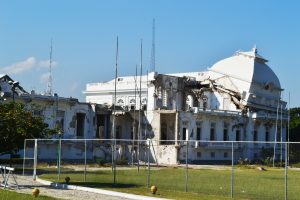76 Latin America and the Caribbean (LACAR): Economic Geography II – Poverty in Haiti
Haiti is the most impoverished country in the Western Hemisphere and, in our terminology, thus of the Western World.
Haiti shares the island of Hispaniola with the Dominican Republic. Although there are two countries on the same island, Haiti’s portion (36.4% of the area of Hispaniola) is strikingly poorer than the Dominican east.
For 2020 Focus Economics ranks Haiti as the 6th poorest country in the world and the only Western World country in the bottom ten. This ranking marks Haiti with a GDP per capita of $923. For a chart showing these bottom ten countries, go to https://tinyurl.com/haitianpoverty In contrast, the GDP per capita across the border in the Dominican Republic is $8050 (2018), about 8½ times higher than in Haiti.

Cartography by Steve Banas.
On the Human Development Index (HDI – 2018) Haiti ranks 169th out of 189 countries. The next lowest in development in the Western World lists as the Solomon Islands, ranked at 153rd.
Worldwide what are the characteristics and the causes of poverty? How well do they apply to Haiti?
What is correlated with poverty? Let us consider these factors – landlocked, violent conflict, debt, disease, natural disasters, corruption, and inequality.

Photo by Claudia Altamimi on Unsplash.
1 – Landlocked. This lack of ocean borders often is a criterion for poverty, but of course, Haiti is an island country, so this does not apply. The six countries ranking lowest on HDI are landlocked countries in Africa. Haiti achieves poverty without the handicap of being landlocked.
2 – Conflict, violence, and war. An interesting concept is the Conflict Trap, a variation of the Poverty Trap. Violent conflict and poverty can be linked in a negative feedback loop where conflict leads to poverty which leads to conflict which leads to poverty, and so on. Violent conflict can cause “a reversal of economic development, which in turn increases the likelihood of future violent conflict. … Agreeing with the Conflict Trap, a country ranked at the bottom 10% on a global poverty scale is six times more likely to see violent civil conflict than a country at the top 10%.”1
This makes sense historically and contemporarily here. Haiti was founded out of native poverty that led to violent revolution in 1791-1804. Haiti won its independence from France, but took on large debt in doing so. France forcefully demanded reparations for the loss of its slave colony, agreeing in 1825 and then revising payment lower in 1838 to 90 million francs (the equivalent of $21 billion now). Haiti paid off this debt in 1947, but this historical debt burdened all of Haiti’s independent nationhood.
In recent years, violence has been an issue. United Nations peacekeeping forces helped maintain order from 2003-2017. In 2019, violent outbreaks in Haitian slums prompted the term “anarchy” in Reuters reporting. In the Global Peace Index for 2019, Haiti ranks 83rd out of 163 countries. It may be that being an island State is helpful for peace, as Iceland ranks 1stand New Zealand 2ndin this index; however, Haiti is an island and ranks average in violence. There is no civil war in Haiti. Arguably, violence has some impact on poverty there.

Another example of a Poverty Trap involves disease. Sick people produce less income which means less money for medical care which means staying sick which again means less income and so on. Haiti ranks second in LACAR to the Bahamas in terms of the highest percentages of population that is HIV+; moreover, Haiti scores third in LACAR in terms of total numbers of HIV+ cases, after the much more populous Brazil and Mexico.
Following the 2010 earthquake in Haiti, there was a major cholera outbreak (ironically, brought accidentally by United Nations peacekeepers). Only by January 2020, ten years later, was cholera eliminated from Haiti. Haiti ranks worst in LACAR in potable water supply with 35% lacking basic drinking water.
So, yes, the feedback loop of disease and poverty in Haiti is significant.
3 – Natural Disasters. Haiti and the island of Hispaniola lie on a tectonic plate boundary, positioning the island in the type of location that produces earthquakes. The 2010 earthquake causes massive property damage and catastrophic loss of life.

Photo by Trocaire from Ireland.
The epicenter of the 7.0 magnitude quake was only sixteen miles from Port-au-Prince, the national capital. As seen here, the National Palace was one of thousands of heavily damaged buildings.
Haiti’s location is in the Atlantic Ocean’s hurricane belt. Significant hurricane damage occurred there in 2016 – Hurricane Matthew, 2010 – Hurricane Tomas, and 2008 – Hurricanes Gustav, Hanna, and Ike. Earthquakes, along with hurricanes and associated flooding, regularly cause significant property damage and some loss of life in Haiti.
4 – Political Corruption. In 2008, Transperancy International, a global coalition against corruption, ranked Haiti as the fourth most corrupt country in the world. Since then, Haiti has improved to 161th best out of 180 countries in 2018. For instance, the Petrocaribe policy with Venezuela was intended to reduce the price of oil purchases for Haiti; however, Haitian auditors have revealed that about $2 billion of these savings are missing, thus not available for their intended use in social development. These sorts of things are not new, probably peaking under the regime of President Jean-Claude Duvalier – 1971-1986.
In the 2020 Index of Economic Freedom, Haiti ranked 153rd out of 180 in the world, in LACAR marking ahead of only Ecuador, Suriname, Bolivia, Cuba, and Venezuela.
5 – Inequality. Haiti scored 41.1 on the GINI index for 2018. In this statistic of wealth inequality, a rating of zero would be perfect equality, while a rating of 100 would have one person owning everything. This is 56th highest inequality of 153 countries. Inequality often prompts dissatisfaction and sometimes violence.

There are a number of factors that affect poverty in countries worldwide. Haiti does not feature all of these factors, for it is not landlocked; however, the other elements explained here do find resonance in Haiti. The socioeconomic factors are not independent of each other, but have interrelationships that make poverty more complex and more intractable. The Haitian people suffer the consequences.
Did You Know?
Following the earthquake of 2010, musicians recorded a new version of “We are the World” in order to bring attention to the dire needs of the people of Haiti. See the official music video on Youtube at https://www.youtube.com/watch?v=Glny4jSciVI
In the Peace Index, the United States ranks a dismal 128th.
In terms of violence and poverty, note that South Sudan ranks 161st out of 163 in the Peace Index, while ranking 186th out of 189 in the Human Development Index. Civil war in Sudan and South Sudan clearly tallies with poverty there.
Hot Off the Press
Cited and additional bibliography:
1 Hiller, Patrick. 2016. “Poverty: A Contributing Factor to Civil War? · Peace Science Digest.” Peace Science Digest. April 1, 2016. https://peacesciencedigest.org/poverty-a-contributing-factor-to-civil-war/.
Banas, Steven. 2020. “Poverty Levels in Haiti.” College of DuPage GIS class. Instructor Joseph Adduci.
FocusEconomics. 2019. “The Poorest Countries in the World (2019-2023).” FocusEconomics | Economic Forecasts from the World’s Leading Economists. November 19, 2019. https://www.focus-economics.com/blog/the-poorest-countries-in-the-world.
“Haiti Cholera Outbreak ‘Stopped in Its Tracks.’” 2020. UN News. January 24, 2020. https://news.un.org/en/story/2020/01/1056021.
Herlinger, Chris. 2019. “Haiti’s Civil Unrest Reaches Chaotic, Disruptive Point.” Global Sisters Report. December 2, 2019. https://www.globalsistersreport.org/news/world/ministry/news/haitis-civil-unrest-reaches-chaotic-disruptive-point.
Paultre, Andre, and Sarah Marsh. 2019. “Haitian Slums Descend into Anarchy as Crisis Sparks Worst Violence in Years.” Reuters, December 10, 2019. https://www.reuters.com/article/us-haiti-violence-feature/haitian-slums-descend-into-anarchy-as-crisis-sparks-worst-violence-in-years-idUSKBN1YE2RX.
Pike, John. 2013. “Haiti – Corruption.” Globalsecurity.Org. 2013. https://www.globalsecurity.org/military/world/haiti/corruption.htm.
“The History of Natural Disasters in Haiti – UFondwa-USA, Inc.” 2018. UFondwa-USA, Inc. February 22, 2018. https://ufondwa.org/history-natural-disasters-haiti/.
Trocaire from Ireland. 2012. Ruins of the Cathedral in the Centre of Port Au Prince. https://commons.wikimedia.org/wiki/File:Ruins_of_the_Cathedral_in_the_centre_of_Port_au_Prince.jpg. Creative Commons Attribution 2.0 Generic.


